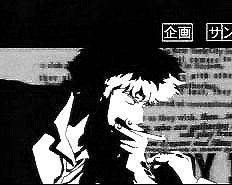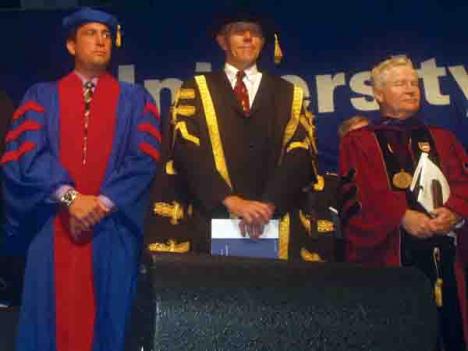Cowboy Bebop: JapanaFunk Anime Shows How Its Done.

April 9, 2003
Cowboy Bebop, a neo-noir space opera that shows the audience the definitive snapshot of early twenty-first century pop, has come to the U.S., opening last Friday at art houses and middling-to-mainstream independents across the nation. Geeks of every stripe and every language will naturally already know all about it, geeks generally being two steps and six psychedelic tablets ahead (or outside) the mainstream, but for the everyday live-action movie fella or fellette, Cowboy Bebop will be a eyewashing surprise. Originally an animated television in Japan, it was dubbed and released to the U.S. market on the inimitable Cartoon Network.
Bebop the movie is a feature-length animation aimed at nobody in particular, that is, the young, grown-up nobodies that populate the halls of the poor and the restless. This is the audience that’s bored, intelligent and cynical, but still needs that romantic fix, as long as it comes with sarcasm as a side dish. Cowboy Bebop has a sci-fi plot strapped on a character-driven collage of every visual, artistic and narrative device in the known universe, and a kicking funk and blues soundtrack. Directed by Shinichiro Watanabe, a very serious young gentleman, Bebop has a wry, self-knowing auteur-ship that attempts to walk the fine line between spoofing cultural references and engaging the audience on a dramatic level. The animation is nothing special, technically, the story and the dialogue smart and wry but not spectacular. Bebop comes together when, at times, the watcher can forget his troubles and enjoy the wise, and frank moments of visual clarity as the intersect with the story, and leap, clad in the armor of ennui, into the river of sentiment.
One scene, for instance, of big, tough, macho Jet Black the bounty hunter, soliloquizing in a bar is a typical moment from the cartoon series. As we hear Jet mumbling profundities about time and relationship, we see the cloudy amber of a glass of scotch, the ice melting in the smoky, false light of the bar, silent except for the accidental carillon of the ice sliding against itself as it melts. The irony reaches several levels, and behind the deliberate cheese and the pulp novel referencing, the viewer can almost touch the raw, aching need of the filmmaker for meaning and romance. It’s the trick of making small moments big, something the Japanese have always excelled at, and a hallmark of noir, the most American contribution to the arts in the last century.
Noir is a French term, but Raymond Chandler did it first, with his detective novels that glamorized and lifted bodily into the limelight the desperate struggles of all-to-human characters. Bebop is classic noir, that is, obviously a genre piece, but almost embarrassingly sincere, snide and sentimental at the same time; the plot is basic and the movement of the drama fairly commonplace, but it is beautiful, and the writing has real quality. This fusion of cultural reference and energetic recreation of the most familiar elements of popular entertainment really marks Bebop. Drawing on the Japanese obsession with American life, Watanabe crafts his work to make you aware of this, and we see a curious take on American-inflected future culture, seen through the Japanese eye. He doesn’t stint on the action, either. Cartoon violence has always been more extreme than live-action mayhem; after all, they aren’t real, and doesn’t lend itself to being very affecting, but Bebop manages at several points to straddle the fence, giving the audience enough visceral, adrenaline fueled shocks to remind us why violence is affecting, and not-so-subtly showing off why animation can do mayhem better.
The violence is remarkable. Bebop is less Tom and Jerry than it is Natural Born Killers. We get mass-market mayhem and individual bullets entering individual faces, and it forcibly reminds one why so many goreporn movies are not good; the action is too unreal and the stories stupider than a drunk dog. Because Bebop takes so much more care with its characters and atmosphere, its violence means more than any scruffy Vin Diesel brutalizing the scenery, and its cartoon blood is realer than the ketchup that fills a scary movie because of the attention given to it’s significance. This won’t hold true for those who simply can’t get over the fact that the actors aren’t real people.
All that aside, the movie has real problems. It’s probably twenty minutes longer than it should be, and for all the care taken with visuals and mood, the story is thin. Certainly not thinner than many a live-action snoozer, but regardless, 119 minutes might be too long to get to know these characters: Spike, Jet, Faye, Ed (a girl) and Ein (a welsh corgie). If you don’t know the cartoon, you will miss many of the jokes and much of the character setup is hastily pasted on for the uninformed. That’s a shame because the characters are deep and original, spoofing and twisting common action stereotypes into unique configurations.
And, if you aren’t in the mood for animation that takes itself seriously, you just won’t like it. Some people don’t like cartoons; they are irredeemable Luddites, and should leave Bebop alone. While it doesn’t take much to beat out the standard American fare of kiddie cartoons, but as good as Bebop is, it still can’t approach the best that cinema can offer, simply because of the limitations of the medium. A must-see for geeks and space nerds, it’s worth plunking down a sawbuck even if you don’t like anime, just to see what all the fuss is about.






















































